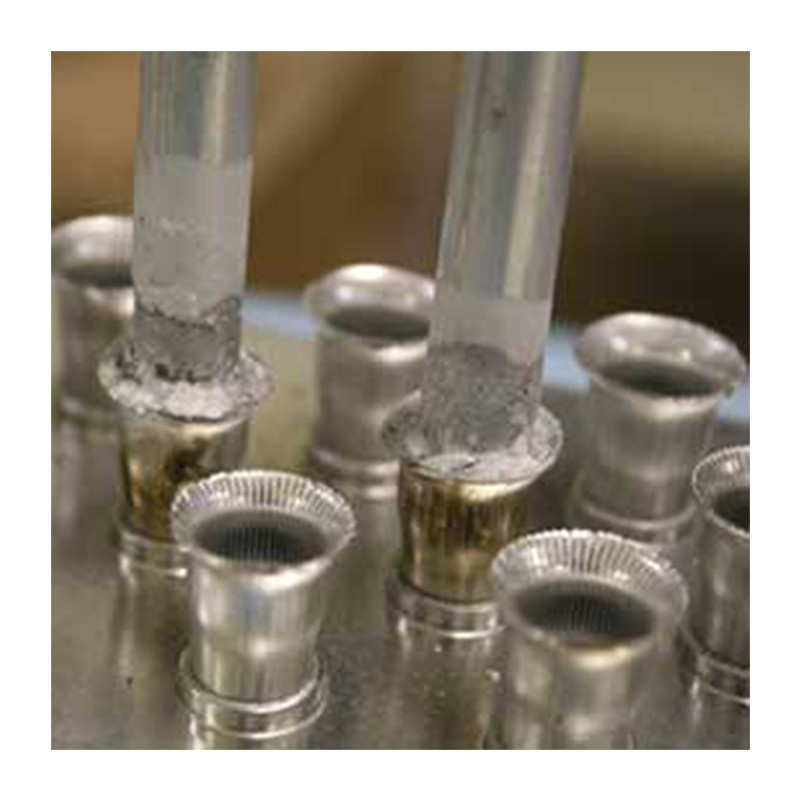

Sie müssen eingeloggt sein
Category


Fotos dienen nur zu Informationszwecken.
please use latin characters
Hartlöten ist ein Verfahren zum Verbinden von Metallelementen mit Loten aus Metalllegierungen, deren Schmelztemperatur über 427 °C liegt, jedoch unter der Schmelztemperatur der zu verbindenden Teile. Diese Technik ermöglicht das Verbinden gleicher sowie unterschiedlicher Metalle.
Hartgelötete Verbindungen:
Die Art des beim Hartlöten verwendeten Lotes hängt von den zu verbindenden Teilen ab. Am häufigsten werden Kupfer-Phosphor-, Silber-, Aluminium-, Kupfer-, Nickel- und Kobalt-Lote eingesetzt.
Moderne induktive Erwärmungssysteme ermöglichen eine zuverlässige, kontaktlose und energieeffiziente Erwärmung in kürzester Zeit – ganz ohne Flamme. Die Zykluszeit einer induktiven Erwärmung ist deutlich kürzer als beim Flammenlöten, sodass mehr Teile in derselben Zeit verarbeitet werden können und dabei weniger Wärme an die Umgebung abgegeben wird. Induktives Löten erlaubt die Kontrolle über Zeit, Temperatur, Fixierung und Positionierung der Teile, was den Prozess reproduzierbar macht und ein einheitliches Endergebnis gewährleistet.
Halbleitersysteme können sehr kleine Bereiche innerhalb enger Toleranzen des Fertigungsprozesses erhitzen, ohne die individuellen metallurgischen Eigenschaften zu beeinträchtigen. Bei großen Stückzahlen oder qualitätskritischen Anwendungen können Teile induktiv in einer Schutzatmosphäre ohne Flussmittel und ohne kostspielige Reinigungsverfahren gelötet werden, wodurch Oxidation reduziert wird.
Interessieren Sie sich für dieses Produkt? Benötigen Sie zusätzliche Informationen oder individuelle Preise?
Sie müssen eingeloggt sein
Hartlöten ist ein Verfahren zum Verbinden von Metallelementen mit Loten aus Metalllegierungen, deren Schmelztemperatur über 427 °C liegt, jedoch unter der Schmelztemperatur der zu verbindenden Teile. Diese Technik ermöglicht das Verbinden gleicher sowie unterschiedlicher Metalle.
Hartgelötete Verbindungen:
Die Art des beim Hartlöten verwendeten Lotes hängt von den zu verbindenden Teilen ab. Am häufigsten werden Kupfer-Phosphor-, Silber-, Aluminium-, Kupfer-, Nickel- und Kobalt-Lote eingesetzt.
Moderne induktive Erwärmungssysteme ermöglichen eine zuverlässige, kontaktlose und energieeffiziente Erwärmung in kürzester Zeit – ganz ohne Flamme. Die Zykluszeit einer induktiven Erwärmung ist deutlich kürzer als beim Flammenlöten, sodass mehr Teile in derselben Zeit verarbeitet werden können und dabei weniger Wärme an die Umgebung abgegeben wird. Induktives Löten erlaubt die Kontrolle über Zeit, Temperatur, Fixierung und Positionierung der Teile, was den Prozess reproduzierbar macht und ein einheitliches Endergebnis gewährleistet.
Halbleitersysteme können sehr kleine Bereiche innerhalb enger Toleranzen des Fertigungsprozesses erhitzen, ohne die individuellen metallurgischen Eigenschaften zu beeinträchtigen. Bei großen Stückzahlen oder qualitätskritischen Anwendungen können Teile induktiv in einer Schutzatmosphäre ohne Flussmittel und ohne kostspielige Reinigungsverfahren gelötet werden, wodurch Oxidation reduziert wird.
Your review appreciation cannot be sent
Report comment
Report sent
Your report cannot be sent
Eigenen Kommentar verfassen
Review sent
Your review cannot be sent
